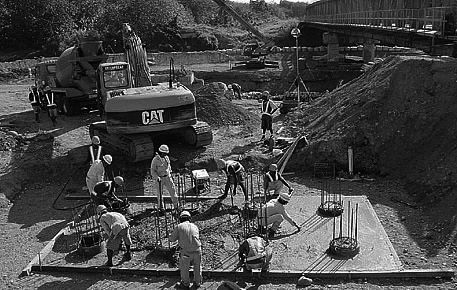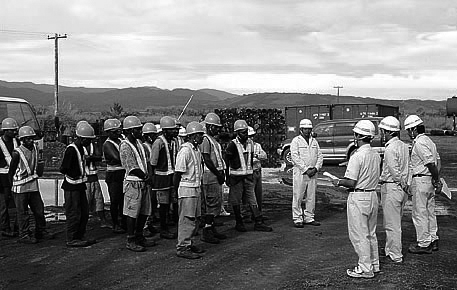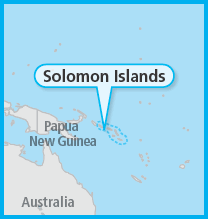Japan's Official Development Assistance White Paper 2009
Column 18 Dedication Led to Successful Construction
— Replacing Bridges in the Solomon Islands —
In the South Pacific, sparkling with blue seas and white coral reefs, there are many island states, spread out like studded jewels. These countries are colored with natural beauty, but they are under the threat of global warming and climate change and also facing economic difficulties. Japan has given focus to dialogues and cooperation with countries in the Pacific Ocean, with which it has historical ties, and in May 2009, hosted the Fifth Japan-Pacific Islands Forum Summit Meeting in Tomamu, Shimukappu, Hokkaido. This column will introduce Japan's cooperation in the Solomon Islands, which was one of the participating countries in this Summit.
Guadalcanal, the largest island in the Solomon Islands which consists of nearly 1,000 islands, is the heart of the country. Bridges connecting arterial highways on the island were built during the period of rule by the United Kingdom and had not been replaced after the island gained independence in 1978. They were thus aging and in very dangerous condition. Japan, in response to a request from the Government of Solomon Islands, began cooperation to replace these bridges in 2006. One of the people from Japan carrying out this cooperation was Mr. Yoshihisa Nakano from Kitano Construction Corporation. Mr. Nakano had extensive experiences in civil engineering work including the construction of fishery facilities in Central America, but he encountered various problems in implementing construction in the Solomon Islands.
The large amount of rain in Guadalcanal troubled Mr. Nakano who was overseeing construction of the bridges. "During the dry season when there is little rain, we wanted to complete construction of three replacement bridges from the foundation portion up to the bridge beams, but there was unusual weather and we were hit by torrential rains seven times, so we were forced to redo the construction at that time. We struggled very hard to make up for delays in the construction schedule due to factors such as flooding caused by heavy rains and materials being washed away," says Mr. Nakano, looking back at the difficulties of carrying out construction while facing challenges posed by nature.
There were 150 workers from the Solomon Islands, but their way of doing construction was different from that in Japan, starting with their methods for using tools, such as pushing downwards to cut with a saw. "In order to do efficient construction, it is important to work out a plan. The success of the construction depended on how well we could convey this to the workers of the Solomon Islands," comments Mr. Nakano. Management of a construction plan and its progress requires that all people involved are informed. People from the Philippines had also been working there, and it was decided that Japanese construction methods would be conveyed to the people of the Solomon Islands through them. As a result of this approach, the Japanese construction methods were gradually picked up by the people of the Solomon Islands, and the construction of the three bridges progressed efficiently. Mr. Nakano says, "The people of the Solomon Islands mastered the Japanese construction methods and worked with dedication. I was impressed by their strong will, and I am grateful to them."
At the three bridges that were completed, the weight limit for cars was increased from 20 tons to 60 tons, and the travel speed was raised significantly from 10 km/h to 50 km/h. This has greatly changed the lives of the people on the island. Simon, who drives a tank truck, says happily, "Previously the bridge was dangerous so I could only use a light truck, but now I can transport everything in one go with a tank lorry. This has made shipping much easier." An island resident who transports fruits and vegetables to the island's central market each day says with a smile, "Being able to travel safely and smoothly is like a dream. My life and work are now much easier."
The replacement of the three bridges has brought together more people on the island. It is now expected that the increase in traffic on the island will lead to further development of the lives and economy of the people in the Solomon Islands.

Workers carrying out construction of a foundation. (Photo: Mr. Nakano)

Workers confirming the work plan at a morning meeting. (Photo: Mr. Nakano)

